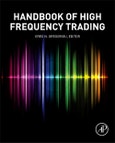This comprehensive examination of high frequency trading looks beyond mathematical models, which are the subject of most HFT books, to the mechanics of the marketplace. In 25 chapters, researchers probe the intricate nature of high frequency market dynamics, market structure, back-office processes, and regulation. They look deeply into computing infrastructure, describing data sources, formats, and required processing rates as well as software architecture and current technologies. They also create contexts, explaining the historical rise of automated trading systems, corresponding technological advances in hardware and software, and the evolution of the trading landscape. Developed for students and professionals who want more than discussions on the econometrics of the modelling process, The Handbook of High Frequency Trading explains the entirety of this controversial trading strategy.
Please Note: This is an On Demand product, delivery may take up to 11 working days after payment has been received.
Table of Contents
Trading Activity
1. High-Frequency Activity on NASDAQ
2. Profitability as a Function of the Holding Period with Implications for High Frequency Trading
3. Data Characteristics for High-Frequency Trading Systems
4. The Relavance of Heteroskedasticity and Structural Breaks when Testing for a Random Walk with High Frequency Financial Data: Evidence from ASEN Stock Markets
5. The Closer the Better? High Frequency Trading and Limitations to Arbitrage Opportunities in Spatially Segmented Markets
6. EU High Frequency Trading Regulation: Mandatory Disclosure and New Investors
Evolution and the Future
7. High Frequency Trading: Implications for Market Efficiency and Fairness
8. Revisioning Revisionism: A Glance at HFT's Critics
9. High Frequency Trading: Evolution and Future
10. High Frequency Trading and Predatory Behavior in the Australian Equity Markets
11. Global Stock Exchanges in the High Frequency Trading Vortex
Liquidity and Execution
12. Measuring Equity Market Liquidity with High Frequency Trading Data
13. We Missed It Again! Why So Many Market Orders in the High Frequency FX Trading Fail to be Executed
14. On The Sharpe Ratio for High Frequency Traders
Impact of News Releases
15. Do High Frequency Traders Care About Earnings Announcements? An Analysis of Trading Activity Before, During, and After Regular Trading Hours
16. Why Accountants Should Care About High Frequency Trading
17. High Frequency Trading under Information Regimes
18. Effects of Firm-Specific Public Announcements on Market Dynamics: Implications for High Frequency Traders
19. Machine News and Volatillity: The Dow Jones Industrial Average and the TRNA Real-Time High Frequency Sentiment Series
Impact of Volatility
20. Technical Trading Strategies at High Frequency: Insights for Practitioners
21. High-Frequency News Flow and States of Asset Volatility
22. News Releases and Stock Market Volatility: Intraday Evidence from Borsa Istanbul
23. The Low Risk Anomaly Revisited on High Frequency Data
24. Measuring the Leverage Effect in a High Frequency Framework
Authors
Greg N. Gregoriou School of Business and Economics, State University of New York, Plattsburgh, NY, USA.A native of Montreal, Professor Greg N. Gregoriou obtained his joint Ph.D. in finance at the University of Quebec at Montreal which merges the resources of Montreal's four major universities McGill, Concordia, UQAM and HEC. Professor Gregoriou is Professor of Finance at State University of New York (Plattsburgh) and has taught a variety of finance courses such as Alternative Investments, International Finance, Money and Capital Markets, Portfolio Management, and Corporate Finance. He has also lectured at the University of Vermont, Universidad de Navarra and at the University of Quebec at Montreal.
Professor Gregoriou has published 50 books, 65 refereed publications in peer-reviewed journals and 24 book chapters since his arrival at SUNY Plattsburgh in August 2003. Professor Gregoriou's books have been published by McGraw-Hill, John Wiley & Sons, Elsevier-Butterworth/Heinemann, Taylor and Francis/CRC Press, Palgrave-MacMillan and Risk Books. Four of his books have been translated into Chinese and Russian. His academic articles have appeared in well-known peer-reviewed journals such as the Review of Asset Pricing Studies, Journal of Portfolio Management, Journal of Futures Markets, European Journal of Operational Research, Annals of Operations Research, Computers and Operations Research, etc.
Professor Gregoriou is the derivatives editor and editorial board member for the Journal of Asset Management as well as editorial board member for the Journal of Wealth Management, the Journal of Risk Management in Financial Institutions, Market Integrity, IEB International Journal of Finance, and the Brazilian Business Review. Professor Gregoriou's interests focus on hedge funds, funds of funds, commodity trading advisors, managed futures, venture capital and private equity. He has also been quoted several times in the New York Times, Barron's, the Financial Times of London, Le Temps (Geneva), Les Echos (Paris) and L'Observateur de Monaco. He has done consulting work for numerous clients and investment firms in Montreal. He is a part-time lecturer in finance at McGill University, an advisory member of the Markets and Services Research Centre at Edith Cowan University in Joondalup (Australia), a senior advisor to the Ferrell Asset Management Group in Singapore and a research associate with the University of Quebec at Montreal's CDP Capital Chair in Portfolio Management. He is on the advisory board of the Research Center for Operations and Productivity Management at the University of Science and Technology (Management School) in Hefei, Anhui, China.








